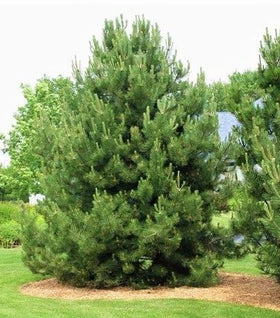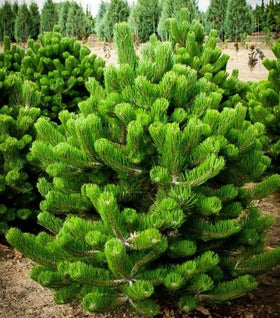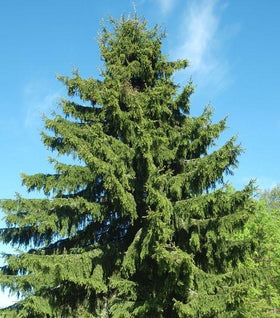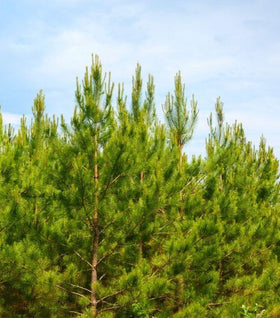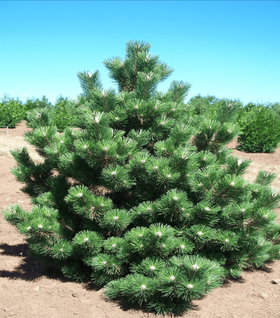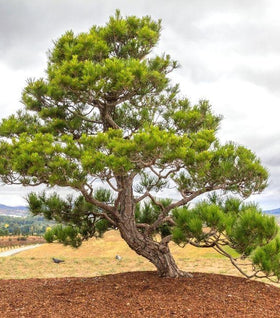Pine Trees for Sale Online
Pine Trees are one of our favorite tree species for a variety of reasons. These trees produce green needles, pine nuts and are most commonly known for their use as Christmas trees. They are fast-growing, evergreen trees, which means they stay green all year long and are long-lived. Pine trees are well known to be drought-tolerant and can survive short dry seasons with no stress.
The roots of a pine tree are complex and extensive and can seek moisture from deep in the ground. Pine trees are moderately growing trees and grow between 1 to 3 feet per year after establishment. Pines also provide excellent habitats for small wildlife like birds to live and forage. Pines are hardy trees that are used for windbreaks, privacy screens, and as buffer trees.
For more information on using Pine Trees as a Privacy Screen read our blog: Easy Ways to Use Privacy Trees in your Yard.
How to Plant a Pine Tree
- The best time of year to plant your pine tree is around late August or early September and October. Planting a pine tree is easiest when it is not too hot or too cold. However, you can plant these trees any time throughout the year.
- Find a spot in your lawn, garden, or landscape that will provide enough space for your tree to grow big and tall. Also, try to plant in an area that receives plenty of sunlight throughout the day.
- Dig a hole that is twice the width of the root ball and no deeper than its height. Try not to make the hole too big, just a perfect-sized pocket for the root ball to sit.
- Once your tree is in the hole, fill the hole with soil. Make sure the tree is standing up straight to ensure it establishes and grows best. Having an extra hand would be helpful at this time. Do not pack the soil too firmly, or water will not be able to drain through it.
- If you tie your tree with any binding, periodically check to ensure the binding is not girdling as the tree grows.
Pine Tree Care for All Types
Light: Pine trees prefer full sunlight; however, they will grow in partial shade. Note that if your pine tree is in the partial shade, it will grow in a more open and airy habit than most pines. Pine trees are evergreen and will last all year long regardless of sun exposure.
Soil: Pines prefer acidic soils, and generally, they can maintain their acid levels due to the needles falling from the tree. We recommend that you leave the needles on the ground under the tree rather than raking them up.
Doing so will help your tree naturally keep its soil levels acidic. Always remember to provide your pine tree with soil that has excellent drainage.
Water: If you have recently planted a young pine tree, it will not need as frequent watering as some other young trees do. Pine trees are tap-rooted trees which means they have long central roots that give the trees the ability to tap into water sources further down into the soil profile.
For this reason, pine trees can be planted closer together or even mixed among other deciduous trees without competing for precious soil moisture at the surface. Fact: watering pine trees less frequently will encourage the taproot to grow.
Fertilizer: During the first few years after planting, we recommend that you fertilize your pine tree twice a year. You can use a fertilizer like Espoma Soil Acidifier to help maintain elevated acid levels in the soil.
Use this feeding method until the tree is old enough to take care of its own needs. The most important thing to remember is your tree needs well-draining soil. Providing these soil conditions will allow the fertilizer to penetrate all around the tree's roots and feed it the nutrients it needs.
Dormancy: You can plant a pine tree at any time of year, providing the soil can be worked. Even though pines hold their "leaves" or needles throughout the winter, they do go into a state of dormancy.
During their dormancy, pine trees roots will continue to grow as long as the soil temperature remains above freezing. Also, because their root system absorbs moisture from deep in the soil, their roots will continue to seek out new moisture sources as well.

